- What is Zepto?
- What Is Zepto Business Model & How Does it Work?
- Zepto Business Model Canvas
- Zepto Revenue Model – How Does Zepto Make Money?
- Competitor Analysis & Market Positioning
- Challenges and Risks in the Zepto Business Model
- Evolution & Future of Zepto
- Conclusion
- Frequently Asked Questions (FAQs)
Table of Contents
Zepto Business Model- How Zepto Works and Makes Money?
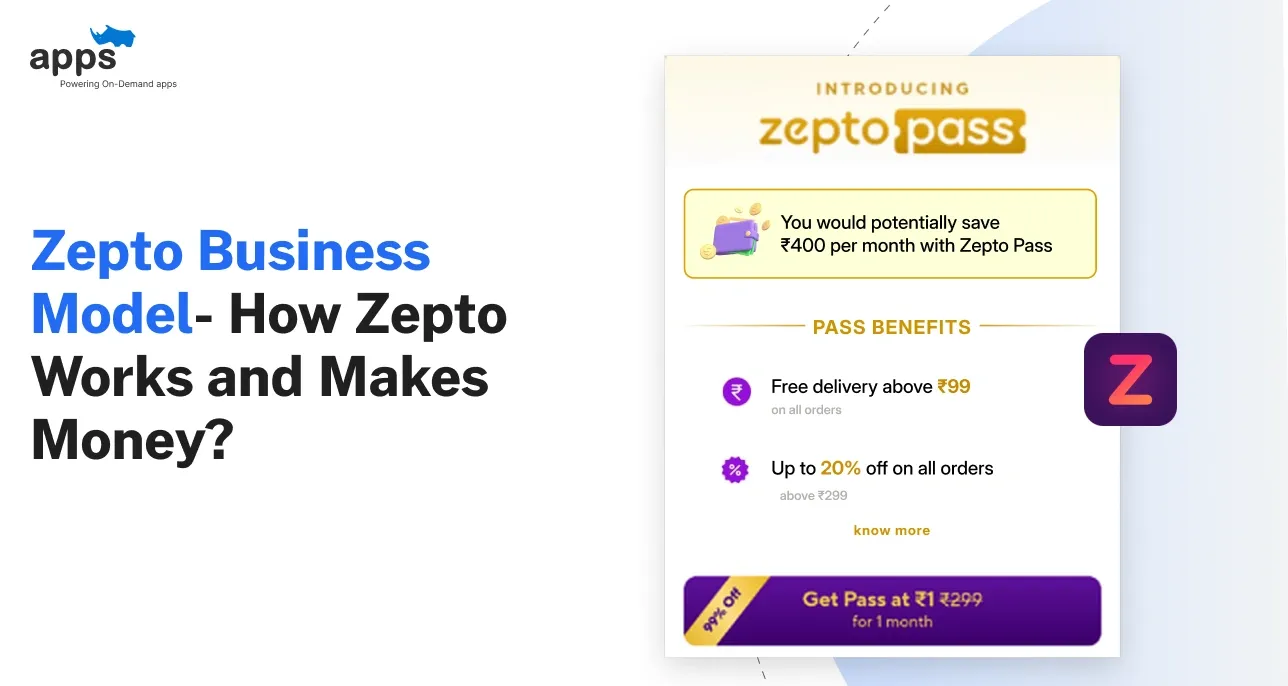
Grocery delivery in India has entered a new era of speed, and Zepto is leading the charge.
While others still measure delivery times in half-hours, Zepto counts them in minutes.
With its smart dark store network, advanced AI-driven logistics, and a bold quick-commerce approach, the Zepto business model has reshaped how people buy everyday essentials.
This blog explores ‘what Zepto business model is, how Zepto delivery works’, and the strategies that make the Zepto company one of India’s fastest-growing startups, all while keeping customers coming back in record time.
What is Zepto?
Zepto is a quick-commerce startup founded in 2021 by Aadit Palicha and Kaivalya Vohra, promising 10-minute grocery delivery through its AI-driven dark store network and last-mile logistics.
Understanding about Zepto company, which operates its own micro-fulfilment centres, ensuring product quality, faster delivery, and real-time inventory control. Through the Zepto app, users can order groceries, daily essentials, and snacks with seamless tracking and secure payments.
Backed by advanced demand forecasting and vertical integration, the Zepto business model prioritizes speed, efficiency, and customer satisfaction.
Competing with Blinkit, Swiggy Instamart, and Zepto, Instamart continues to expand through private-label products and dark-store franchise partnerships.
What Is Zepto Business Model & How Does it Work?
The Zepto business model is built around one promise: delivering groceries in under 10 minutes. Instead of working as a marketplace like BigBasket or Amazon Fresh, Zepto owns and manages its inventory through a network of dark stores and micro-fulfilment centres.
This gives it complete control over product availability, pricing, and speed.
It’s a quick-commerce model powered by AI, demand forecasting, and last-mile logistics, making Zepto grocery delivery faster, smarter, and more reliable than traditional systems.
Let’s know what is Zepto business model and how it works.
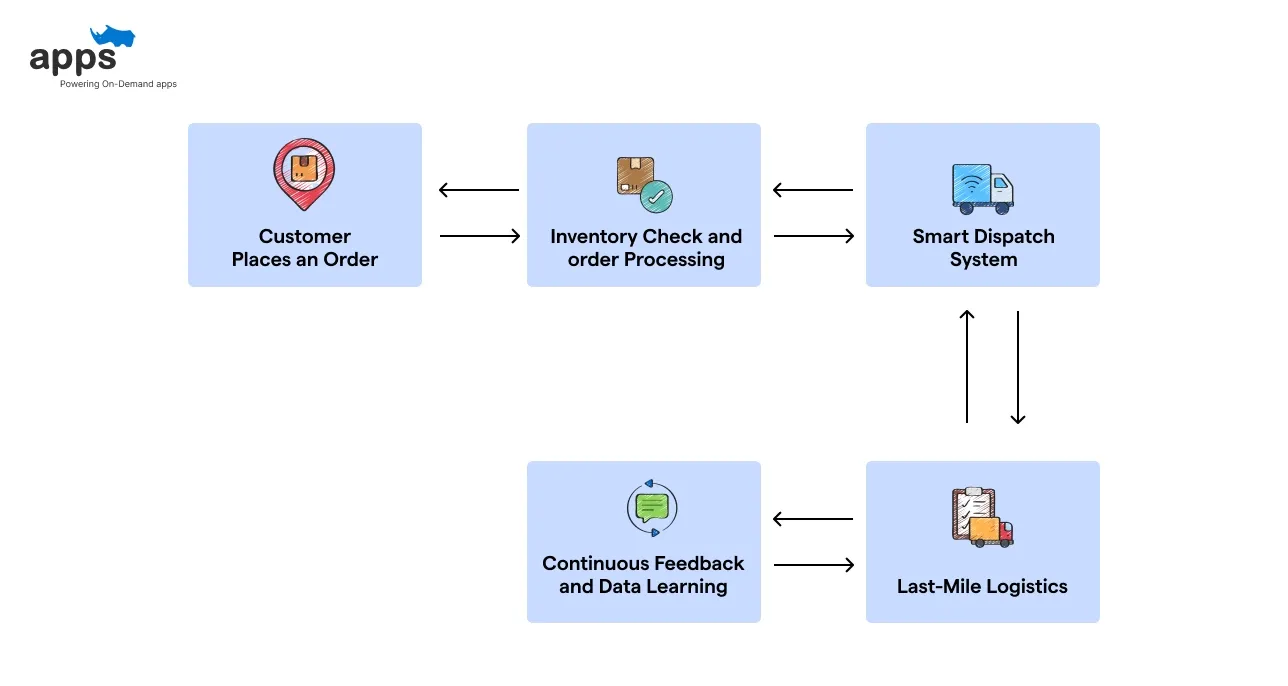 1. Customer Places an Order
1. Customer Places an Order
Through the Zepto app, users browse and select groceries or daily essentials. Orders are automatically routed to the nearest dark store within a 2–3 km radius.
2. Inventory Check and order Processing
Zepto’s AI algorithms forecast demand and maintain real-time stock levels. Once an order is placed, products are picked and packed within 60 seconds at a micro-fulfilment centre.
3. Smart Dispatch System
The order is instantly assigned to the nearest delivery partner based on location, road traffic, and delivery load, using route-optimization algorithms.
4. Last-Mile Logistics
Delivery riders complete the last-mile delivery in under 10 minutes, supported by precise location tracking and dynamic routing.
5. Continuous Feedback and Data Learning
Every order feeds back into Zepto’s demand forecasting system, improving future inventory and delivery efficiency.
This hyper-local fulfilment model keeps operations fast and customer satisfaction high. Compared to Blinkit's business model and revenue model, Zepto’s inventory-led structure provides it with tighter control and consistency.
Zepto Business Model Canvas
Below is a breakdown of Zepto business model using the Business Model Canvas framework, showing how each element supports its fast-growing, quick-commerce ecosystem.
To understand the broader industry, explore how grocery delivery services work, their costs, and their benefits.
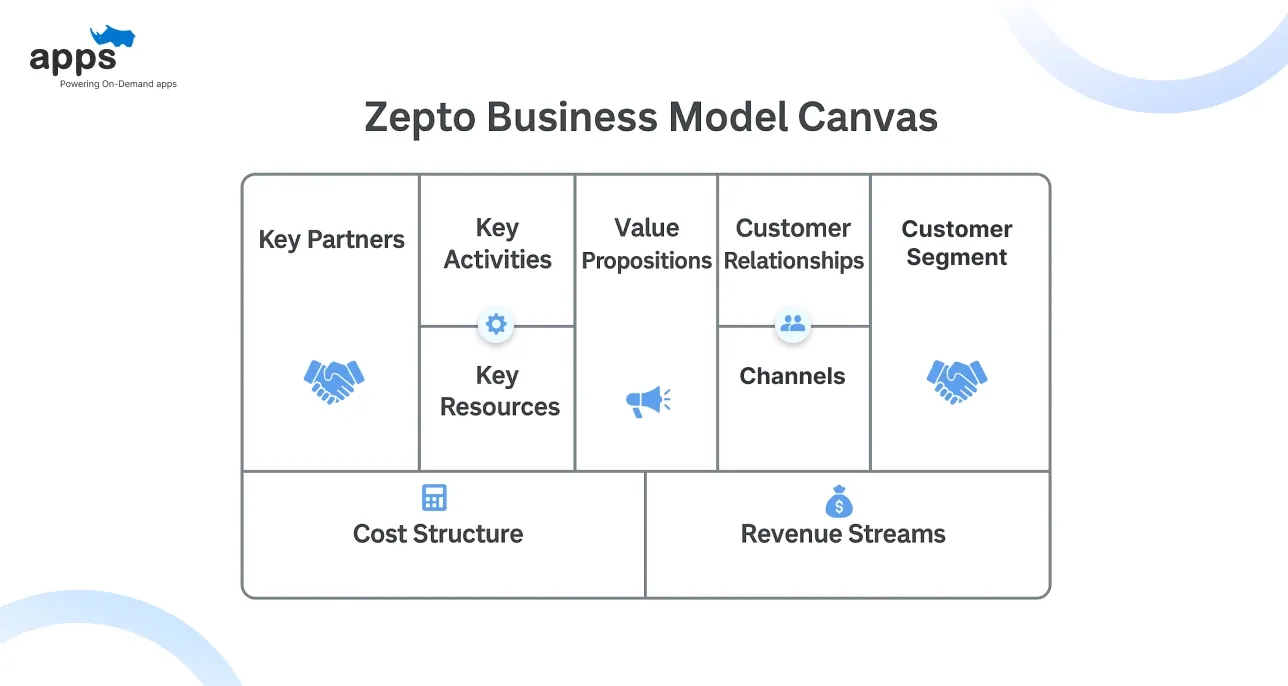
Key Partners
Zepto’s partnerships form the foundation of its supply chain and delivery model.
- Suppliers & FMCG brands ensure steady product availability.
- Delivery partners handle last-mile logistics and fulfilment.
- Tech partners support AI systems, dynamic pricing algorithms, and app optimization.
- Warehouse and real estate partners expand the dark store network.
- Investors drive funding for new market expansion.
Together, these collaborations keep operations scalable and seamless across cities.
Key Activities
The day-to-day operations define how Zepto delivery works efficiently.
- Managing micro-fulfilment centres and dark stores for faster dispatch.
- Running AI-based demand forecasting for stock accuracy.
- Optimizing delivery routes for 10-minute fulfilment.
- Managing marketing campaigns, user engagement, and tech maintenance.
These activities allow Zepto to deliver speed without compromising reliability.
Key Resources
Zepto’s resources give it a competitive edge in quick-commerce.
- AI and data analytics tools for forecasting and stock planning.
- A strong Zepto app platform and cloud infrastructure.
- A trained workforce managing warehouse and logistics operations.
- A vast dark store network built for scalability.
These assets ensure that Zepto stays agile, data-driven, and customer-focused.
Value Proposition
The Zepto company focuses on creating value for every stakeholder.
- For customers: Instant delivery, affordability, and consistent quality.
- For partners: Growth through Zepto dark store franchise and supply partnerships.
- For Zepto: High retention and improved customer lifetime value (CLV) through reliability.
This mix of speed, accessibility, and trust sets Zepto apart in the quick-commerce space.
Customer Segments
Zepto business model canvas targets modern consumers who value convenience and speed.
- Urban professionals, students, and families need quick essentials.
- High-frequency shoppers in metro areas.
- Local entrepreneurs joining through Zepto warehouse partnerships.
These segments fuel Zepto’s growth across Tier 1 and Tier 2 cities.
Customer Relationships
Zepto builds long-term loyalty through personalization and consistent service.
- Zepto Pass rewards frequent users with free delivery and discounts.
- AI personalization enhances product suggestions and engagement.
- 24/7 in-app support ensures trust and transparency.
Its strong retention model keeps users returning week after week.
Channels
Zepto reaches its audience where convenience matters most.
- The Zepto application and website are the primary sales touchpoints.
- Digital ads, social media, and influencer campaigns for awareness.
- Referral and omni-channel retail partnerships for expansion.
These multi-channel strategies make the brand instantly accessible.
Cost Structure
Zepto’s cost structure balances technology, logistics, and scalability.
- Tech infrastructure, app development, and data systems.
- Warehouse rent, workforce salaries, and delivery costs.
- Marketing and surge pricing management for profitability.
The efficiency of its vertical integration keeps costs lean while maintaining speed.
Revenue Streams
Zepto’s revenue model is multi-layered, balancing recurring and one-time income.
- Product margins from owned inventory and private labels.
- Delivery fees and surge pricing during peak hours.
- Subscriptions from Zepto Pass and brand promotions.
- Ad placements and data monetization within the Zepto app.
Together, these streams ensure steady growth and rising Zepto profit margins.
Every element in Zepto’s canvas serves a single goal: making grocery delivery faster, more innovative, and more profitable.
Next, let’s see how Zepto turns this structure into revenue.
Zepto Revenue Model – How Does Zepto Make Money?
After outlining how the Zepto business model works, let’s look at how Zepto pulls in revenue.
The model rests on multiple streams that feed into growth, customer retention, and scale, all while managing costs.
1. Product Margins and Pricing Control through Owned Inventory
Zepto owns and operates its dark-store network and directly controls its inventory. This lets the company buy in bulk, control pricing, and manage waste better. While exact margin figures aren’t publicly broken down, this remains the largest revenue source.
2. Delivery and Surge Fees
Delivery used to be a secondary but consistent source of income for Zepto Grocery. Zepto previously charged a platform fee of ₹2 per order and a handling fee of ₹2–₹15 for small-value orders, according to YourStory reports.
According to Navbharat Times reports from November 2025, Zepto removed handling and surge fees and reduced the free delivery threshold to ₹99, thereby optimizing customer retention.
3. Zepto Pass and Loyalty-Based Subscription Models
Zepto’s subscription model creates recurring income while boosting customer loyalty. Zepto Pass, launched at ₹299/month, offers unlimited free deliveries above ₹99, early access to deals, and exclusive offers.
In 2025, Zepto began testing Zepto Daily, a new low-cost program priced at just ₹1 in pilot cities to increase engagement and repeat usage. This helps improve customer lifetime value (CLV) and ensures long-term retention.
4. Advertising and Data Monetisation on the Zepto App
FMCG and local brands pay for promoted listings, in-app banners, and sponsored placements to reach millions of active users. Zepto also leverages data insights to help brands target better, driving ad revenue without disrupting the user experience.
As India’s quick-commerce market scales, Zepto’s retail media business is expected to become a significant contributor to overall Zepto revenue.
5. Private Labels and Zepto Café
Zepto business model continues to expand beyond grocery delivery. Through its private-label products, Zepto earns higher margins and builds stronger brand recall across categories such as dairy, snacks, and daily-use essentials.
Zepto Café marks its entry into the ready-to-eat and beverage segment, delivering coffee, sandwiches, and snacks in under 10 minutes through the same dark-store network. These initiatives diversify Zepto’s revenue streams and reduce dependency on core grocery orders.
Zepto’s revenue model thrives on balance, and its adaptive pricing, vertical integration, and new ventures prove why Zepto is profitable in the evolving quick-commerce landscape.
Competitor Analysis & Market Positioning
Zepto’s advantage comes from an inventory-led quick-commerce playbook: a dense dark-store network, tight last-mile logistics, and AI for demand forecasting.
To see where it stands, here’s a crisp view against Blinkit, Swiggy, Instamart, and BigBasket, the closest rivals shaping India’s hyper-local fulfilment.
Zepto vs Blinkit vs Swiggy Instamart vs BigBasket
Factor | Zepto | Blinkit | Swiggy Instamart | BigBasket |
| Core model | Inventory-led dark stores | Hybrid: partner + dark stores | Marketplace + dark stores | Warehouse + marketplace |
| Delivery speed | ~10 mins focus | 10–20 mins | 15–30 mins | Slot & same-day |
| Control on pricing | High (owned stock) | Medium | Medium | High (own DCs) |
| Coverage | Metros, high-density zones | Metros, Tier-1 | Metros, Tier-1/2 | Pan-India urban |
| Category depth | Daily essentials + Zepto Café, private-label | Essentials + fresh + Zomato Ecosystem | Essentials bundled with the Swiggy ecosystem | Deep groceries + fresh |
| App UX | Fast, minimal friction | Rich, promo-led | Integrated in Swiggy | Feature-rich, planner-led |
| Monetisation mix | Margins, delivery, subs, ads | Margins, fees, ads | Cross-sell via Swiggy + fees | Margins, memberships |
| Customer Support | 24/7 in-app support | 24/7 in-app support | 24/7 in-app support | 24/7 in-app support |
How Zepto Differentiates from Competitors
- Zepto vs Blinkit: Zepto’s fully inventory-led dark store model ensures faster fulfilment and fewer stockouts, while Blinkit’s hybrid marketplace model often relies on third-party stores.
- Zepto vs Swiggy Instamart: Zepto focuses solely on quick-commerce, whereas Swiggy treats Instamart as part of its broader food ecosystem. This helps Zepto optimise speed and category-specific margins.
- Zepto vs BigBasket: While BigBasket focuses on bulk deliveries and same-day fulfilment, Zepto grocery delivery targets impulse and top-up orders through micro-fulfilment centres.
- Tech Edge: Zepto’s AI-driven demand forecasting and 2–3 km delivery radius allow faster turnaround times than any rival in India’s quick-commerce space.
SWOT Analysis
Strengths
- Speed leadership: 10-minute delivery promise with superior last-mile logistics.
- Tech advantage: AI and demand forecasting reduce waste and boost delivery accuracy.
- Brand innovation: Expanding into Zepto Café and private-label products.
- Customer focus: Simplified Zepto app experience drives loyalty and repeat orders.
Weaknesses
- Limited geography: Metro-focused coverage restricts national scalability.
- Thin margins: High operating costs impact Zepto's profit potential.
- Dependence on dark stores: Limits flexibility in rural or Tier-3 markets.
- Cost pressure: Infrastructure and fuel costs affect sustainability.
Opportunities
- Tier-2 city expansion: Rising adoption of quick-commerce in smaller cities.
- Omni-channel retail partnerships: Integration with local kiranas and franchises.
- Zepto store franchise model: Enables faster scaling via partner networks.
- Data monetisation: Leveraging Zepto app analytics for brand collaborations.
Threats
- Regulatory risks: New laws on gig work and dark store operations.
- Aggressive competition: Blinkit and Instamart are expanding loyalty programs.
- Operational volatility: Rising labour and logistics costs.
- Consumer fatigue: Price sensitivity may limit the growth of subscription models.
Challenges and Risks in the Zepto Business Model
While the Zepto business model has reshaped India’s quick-commerce industry, it also faces several challenges that could test its sustainability and profitability as it scales further.
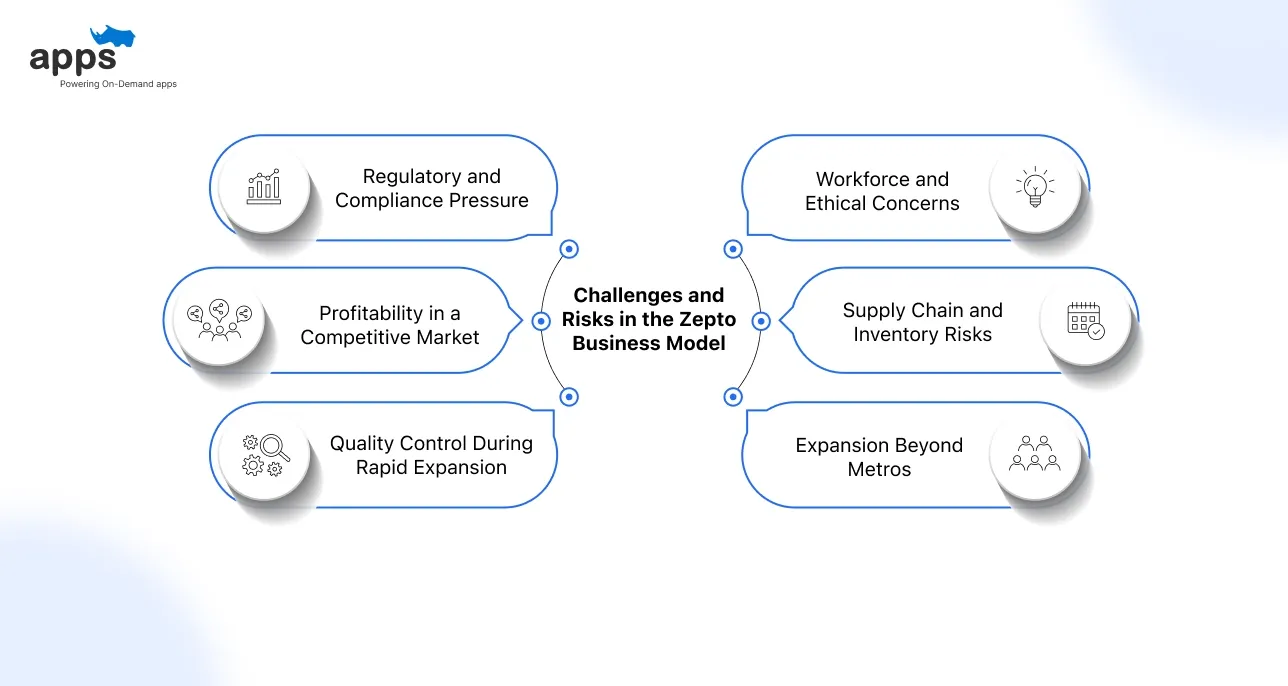
1. Regulatory and Compliance Pressure
Running hundreds of dark stores across Indian cities exposes Zepto to increasing regulatory scrutiny. Local authorities are tightening regulations on zoning, delivery time limits, and food safety.
According to a Financial Express report, in 2025, Zepto’s dark store in Dharavi, Mumbai, faced a temporary license suspension from the Maharashtra FDA for alleged hygiene violations, which was later reinstated after compliance updates.
This reflects the growing oversight on operational standards and safety across the quick-commerce sector.
2. Profitability in a Competitive Market
Balancing costs with margins remains one of Zepto’s most challenging tasks. Maintaining 10-minute deliveries results in high expenses for last-mile logistics, fuel, and staffing. With Blinkit and Swiggy Instamart offering aggressive discounts, sustaining healthy Zepto profit margins is increasingly complex.
3. Quality Control During Rapid Expansion
With operations expanding across 20+ cities and planned rollouts in Tier-2 regions, maintaining delivery accuracy and product freshness is increasingly complex. Any missteps in demand forecasting or stock rotation can directly affect Zepto's revenue and customer trust.
Reports suggest that some quick-commerce dark stores in India have faced food storage and hygiene issues amid expansion pressures
4. Workforce and Ethical Concerns
Zepto business model relies heavily on gig workers who face tight delivery timelines and limited benefits. Managing fair pay, safety, and satisfaction while ensuring operational speed is a growing ethical concern that the Zepto app ecosystem must address responsibly.
5. Supply Chain and Inventory Risks
Running hundreds of dark stores means managing complex supply chains. Delays from vendors, poor route optimization, or weather-related disruptions can cause order delays and inventory loss, impacting customer lifetime value (CLV) and satisfaction.
6. Expansion Beyond Metros
Scaling into Tier-2 and Tier-3 cities comes with unique challenges from infrastructure limitations to unpredictable hyper-local fulfilment costs. Adapting the Zepto delivery model to these areas without hurting efficiency or affordability will be key to sustainable growth.
Despite these hurdles, Zepto’s AI-driven logistics and data-led decisions continue to fuel its edge in India’s quick-commerce space.
Evolution & Future of Zepto
Below are the major moves shaping Zepto's business model and providing more insight about Zepto Company and its future growth.
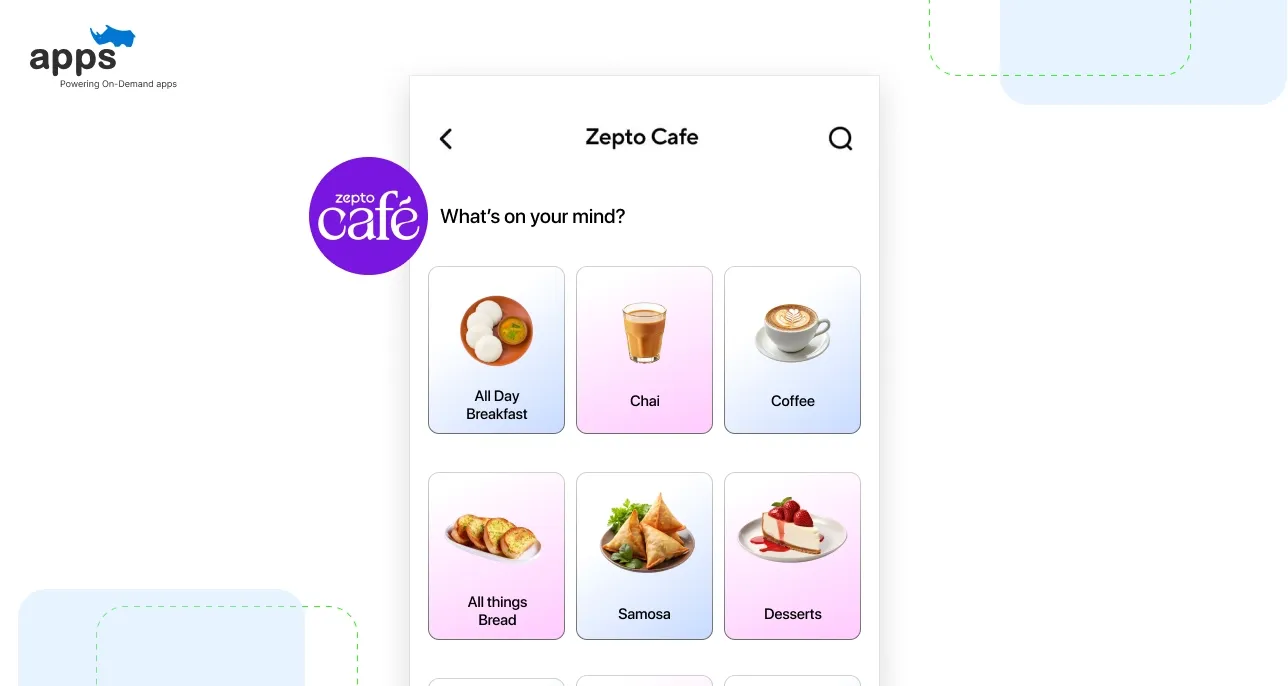
Shift Beyond Groceries: Zepto Café & Private Labels
Zepto grew Zepto Café rapidly post-launch, then paused 44 outlets in several North Indian cities to fix supply-chain gaps, evidence of test-and-learn discipline. Private-label lines continue to be a margin lever.
Product & UX Roadmap: AI, Automation, Personalization
Expect deeper AI demand forecasting, smarter assortments within a 2–3 km radius, and lighter app flows to lift conversion and CLV, the same levers powering its speed edge today (inferred from its AI-led ops and retail-media direction), according to Inc42 Media reports.
New Go-To-Market: Dark-Store Franchise & Partner Warehousing
Zepto now markets a Growth Partner (franchise) program, owns a dark store, serves hyper-local demand, and plugs into Zepto’s tech + supply stack. It’s a capital-light way to scale coverage beyond metros.
Pricing, Memberships & Margin Defense
After a fresh $450M raise, Zepto removed handling/surge fees and dropped the free-delivery threshold to ₹99 to push order frequency. Its Zepto Pass membership (commonly ₹149–₹299/month) bundles free deliveries and perks, as well as tools to defend share while tuning unit economics.
Capital, Profitability Path & Expansion Thesis
According to Reuters reports, funding momentum continues (a recent round valued Zepto at ~$7B). The playbook: densify dark stores, tilt the mix toward non-grocery and private-label products, and scale retail media, aiming to grow contribution margins even as discounts intensify.
Zepto’s direction is clear: keep the dark-store network sharp, expand baskets with higher-margin lines, and use memberships, not fees, to boost loyalty.
Next up, we’ll stitch this into a practical build plan for your marketplace.
Conclusion
The Zepto business model redefined how India experiences convenience. From AI-led dark store networks to 10-minute deliveries, Zepto’s strategy shows that speed, precision, and customer trust can coexist with scale.
Its evolution from Zepto Grocery to Zepto Café and private labels reflects a broader shift where efficiency meets innovation.
For startups and enterprises, Zepto’s story proves what’s possible when technology and logistics align seamlessly.
If you’re inspired to create your own quick-commerce platform like Zepto's business model, AppsRhino gives you the speed, scalability, and intelligence to make it happen. You can start by exploring our end-to-end grocery app development solution. Build smarter, launch faster, and lead your market with confidence.
How to Build an App Like Zepto with AppsRhino
AppsRhino empowers you to build your own quick-commerce app like Zepto Grocery, combining speed, scalability, and flexibility. Trusted by 200+ global brands, including Authentic Drilling, Khatabook, Apollo, Chattahoot, Woodland, and more.
Here’s how you can create a powerful Zepto-like platform with AppsRhino’s unique features:
- Customizable & Whitelabel: Rebrand with your logo, colors, and domain to make it fully yours.
- Multiple Payment Gateways: Integrate Stripe, PayPal, Razorpay, or your preferred gateway effortlessly.
- AI-Powered Automation: Optimize routes, predict demand, dynamic pricing, and personalize experiences intelligently.
- Built-in Monetization Tools: Automate pricing, commissions, and subscriptions with ease.
- Cross-Platform Deployment: Launch instantly on Android, iOS, and web platforms.
- Fastest Time to Market: Launch your Zepto-like app in record time with end-to-end support.
- Third-Party Integrations: Seamlessly connect CRMs, chat tools, and marketing platforms.
- Custom Branding & UX: Deliver an engaging, conversion-optimized experience for every user.
- Analytics Dashboard: Track revenue, performance, and engagement in real time.
- Multi-Store & Franchise Support: Manage dark store networks or Zepto-like dark store franchises effortlessly.
With AppsRhino, you can replicate the efficiency of the Zepto business model, building a fast, data-driven, and scalable platform ready to dominate the quick-commerce market.
Frequently Asked Questions (FAQs)
Where does Zepto get its products?
Zepto sources groceries and essentials from local partner stores, suppliers, and distributors, while also stocking items in its dark-store network for 10-minute delivery.
What is the business structure of Zepto?
Zepto operates privately with centralized management, running dark stores and local partnerships while leveraging technology and logistics to improve operational efficiency.
What is the margin of Zepto?
Zepto’s margins range from 2% to 10% across product categories, supported by delivery fees, private-label products, and operational efficiencies.
What is the commission model of Zepto?
Zepto earns commission fees from partner stores per order. The percentage varies across categories, helping maintain competitive prices and steady Zepto revenue.
How does Zepto differ from other grocery delivery apps?
Unlike Blinkit or Swiggy Instamart, Zepto combines AI-driven logistics, a dark store model for 10-minute grocery delivery, and subscription programs like Zepto Pass to ensure speed and savings.
How does Zepto handle customer complaints?
Zepto offers dedicated in-app support, enabling users to file complaints directly in the Zepto app, ensuring quick resolution and an improved customer experience.
How does Zepto ensure timely delivery?
Zepto ensures 10-minute delivery using AI-powered route optimization, real-time order tracking, and a dense micro-fulfilment centre network for hyper-local execution.
Table of Contents
- What is Zepto?
- What Is Zepto Business Model & How Does it Work?
- Zepto Business Model Canvas
- Zepto Revenue Model – How Does Zepto Make Money?
- Competitor Analysis & Market Positioning
- Challenges and Risks in the Zepto Business Model
- Evolution & Future of Zepto
- Conclusion
- Frequently Asked Questions (FAQs)





